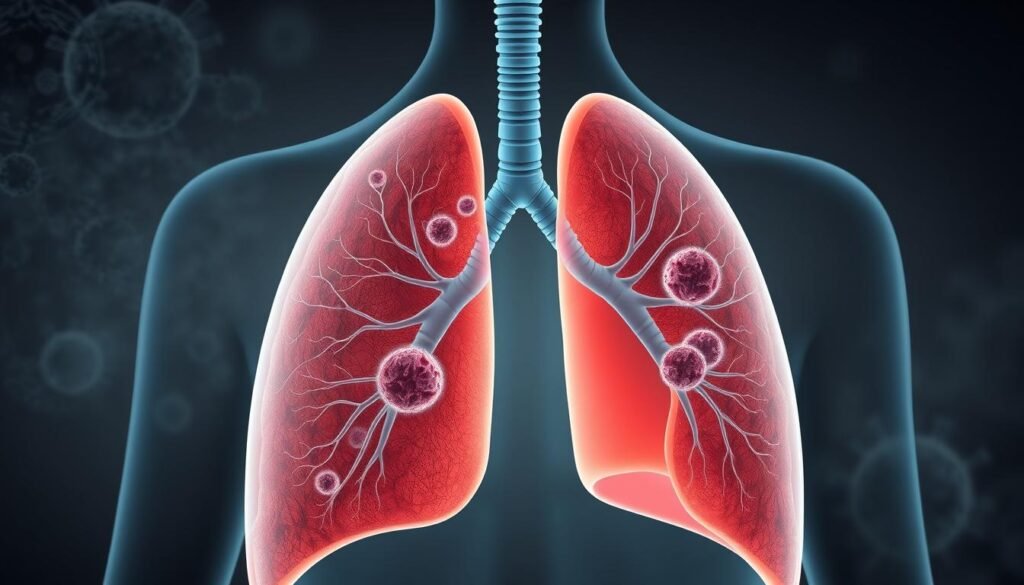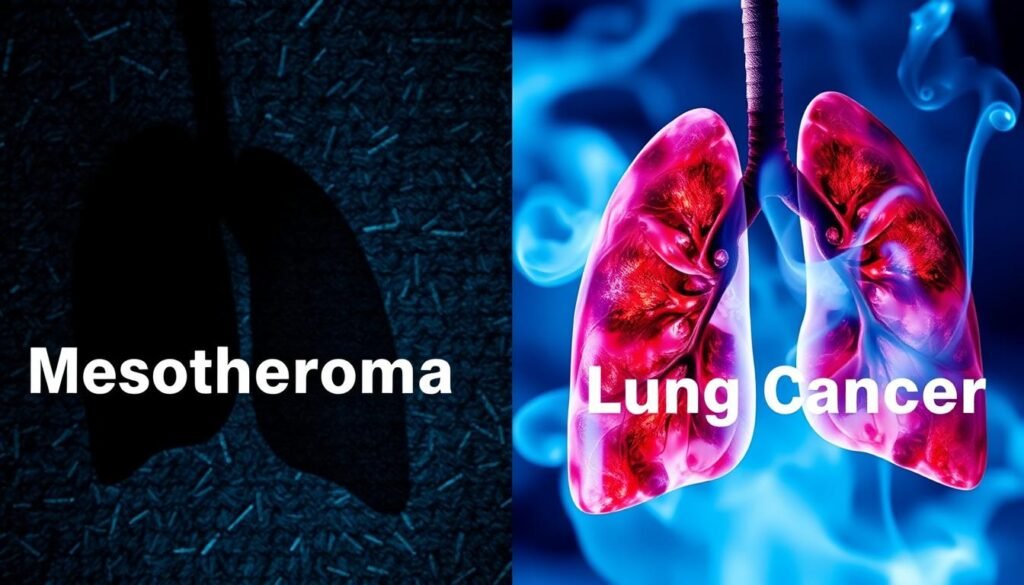Doctors find about 2,800 cases of mesothelioma each year. This is much less than lung cancer, which has roughly 222,500 new cases yearly in the U.S. Both illnesses may seem similar because they develop in the same way and have like symptoms. This makes some people ask: is mesothelioma lung cancer? But, they have big differences, especially in what causes them, their symptoms, and how they are treated.
This article will explain the differences between mesothelioma and lung cancer. Understanding these can help those facing these cancers. It lets them choose the best treatment.
Key Takeaways
- Mesothelioma is diagnosed in about 2,800 patients per year, making it much rarer than lung cancer.
- Lung cancer shows a higher 5-year survival rate at 26% compared to mesothelioma’s 12%.
- Asbestos exposure is the primary cause of mesothelioma, while it is a risk factor for lung cancer.
- Mesothelioma typically demonstrates more localized tumor growth compared to the often metastatic nature of lung cancer.
- About 75% of mesothelioma cases are classified as malignant pleural mesothelioma.
Introduction to Mesothelioma and Lung Cancer
Mesothelioma and lung cancer are two serious illnesses that require our attention. Mesothelioma affects the pleura, which is the lung’s lining. Lung cancer happens within the lung tissue. They both start from abnormal cell growth but have different causes, risks, and treatments.
Lung cancer is quite common, with about 235,000 new cases yearly in the U.S. Mesothelioma is more rare, with around 3,000 cases each year. Yet, asbestos exposure links them together as a cause.
To correctly diagnose and treat, it’s vital to know the differences between mesothelioma and lung cancer. Mesothelioma might show up 20 to 60 years after asbestos contact. Lung cancer can develop quicker, especially in smokers. Other factors like family history and work hazards matter too.
Understanding these illnesses better will help us grasp their causes, symptoms, and treatments. This knowledge is key when discussing these two conditions.
| Aspect | Mesothelioma | Lung Cancer |
|---|---|---|
| Primary Affected Area | Pleura (lung lining) | Lung tissue |
| Common Risk Factor | Asbestos exposure | Smoking |
| Annual Diagnoses | ~3,000 cases | ~235,000 cases |
| Development Time | 20 to 60+ years post-exposure | Varies, often quicker in smokers |
| Treatment Options | Surgery, chemotherapy, radiation therapy | Surgery, chemotherapy, targeted therapy |
What is Mesothelioma?
Grasping the mesothelioma definition is key to understanding its dangers and the impact on health from this rare cancer. It’s an aggressive cancer mainly caused by asbestos exposure. This cancer forms in the mesothelium, a protective layer around internal organs, typically the lungs and chest area.
Every year, the U.S. sees 2,000 to 3,000 new mesothelioma cases. Diagnosis is tricky because symptoms can take 20 to 60 years after asbestos exposure to appear. This long delay makes treatment harder.

Definition and Overview
The mesothelioma overview sheds light on its importance to public health, especially at workplaces. Workers in industries like construction and shipyards face higher risks due to asbestos. The risk of getting mesothelioma is 1 in 770 for these individuals, making awareness and prevention crucial. Chemotherapy is the main treatment, often used with surgery or radiation for better outcomes.
Types of Mesothelioma
There are different mesothelioma types, with pleural mesothelioma being the commonest, making up about 75% of cases. Other types are:
- Pleural Mesothelioma: Hits the lung lining, causing serious breathing issues.
- Peritoneal Mesothelioma: Forms in the stomach lining, leading to digestive problems.
- Pericardial Mesothelioma: Affects the heart’s lining, which can cause heart issues.
Each type affects the body differently, impacting symptoms and treatment plans. Noticing signs early, like a chronic cough or weight loss, is crucial for prompt treatment. For more on symptoms, click here.
What is Lung Cancer?
Lung cancer starts from unusual cell growth in the lungs. It’s often linked to smoking, asbestos, and pollution. Over 230,000 new cases were expected in the U.S. in 2022. It’s hard to catch early because it rarely shows signs at first.
Overview of Lung Cancer
There are two main kinds of lung cancer: non-small cell and small cell. Non-small cell lung cancer (NSCLC) is the most common, making up about 85% of cases. Small cell lung cancer (SCLC) is less common but more aggressive. NSCLC patients usually have a better chance of survival than those with SCLC.

Types of Lung Cancer
Each type of lung cancer has its unique traits and needs for treatment. The main types are:
| Type of Lung Cancer | Description | Percentage of Cases |
|---|---|---|
| Non-Small Cell Lung Cancer (NSCLC) | The most common kind, includes adenocarcinoma and squamous cell carcinoma. | 85% |
| Small Cell Lung Cancer (SCLC) | Known for quick growth and spreading early in the body. | 10-15% |
Knowing the differences is key for effective treatment and better outcomes. For more on lung cancer and how it differs from mesothelioma, check out this detailed article. Early diagnosis and action are vital to improve survival rates and the success of treatments.
Is Mesothelioma Lung Cancer?
Many people are curious if mesothelioma is the same as lung cancer. Though both affect the chest area, they are different. Mesothelioma starts in the lining around the lungs, while lung cancer begins in the lung tissue. Knowing the difference is key for the right diagnosis and treatment.
About 3,000 Americans are diagnosed with mesothelioma each year. This type of cancer comes with different survival rates, depending on its form. Pleural mesothelioma, the most common type, can lead to a life expectancy of 18 to 31 months with treatment. Without treatment, patients may only survive about six months.
Anyone with symptoms of these cancers should get a complete check-up. Imaging scans and biopsies help tell them apart. The time between asbestos exposure and mesothelioma appearing can be 10 to 50 years. This makes early diagnosis harder compared to lung cancer.

Survival rates for mesothelioma vary by type. For example, peritoneal mesothelioma has higher survival rates than pleural mesothelioma. Testicular mesothelioma, a rare kind, has an average survival of 46.7 months.
In conclusion, it’s vital to understand mesothelioma is not lung cancer. They start in different places and respond differently to treatments. This distinction is crucial for managing care correctly.
Key Differences Between Mesothelioma and Lung Cancer
Knowing how differences in location between mesothelioma and lung cancer stand out is key. They start in different tissues, which influences their growth and how they are treated. These differences shape patient care and their chances for a better outcome.
Location and Development of Tumors
Mesothelioma starts in the pleura, the lining around the lungs. In contrast, lung cancer comes from lung tissue itself. This difference in location between mesothelioma and lung cancer changes how tumors appear.
Lung cancer forms large, individual masses with clear edges. But mesothelioma spreads as tiny nodules over the pleura, making it harder to spot and treat.
Growth Patterns
Mesothelioma grows slowly and usually stays in one place. Lung cancer, however, spreads fast to other parts of the body. These growth differences change how doctors approach treatment, including when to operate.
Common Symptoms
Both cancers cause coughing, chest pain, and breathlessness. However, mesothelioma also leads to pleural effusion and thickening. Lung cancer may cause grande weight loss and fatigue. For deep insights into these diseases, check out this link here.
Causes of Mesothelioma
It’s vital to know why mesothelioma happens. It helps with prevention. Asbestos exposure is the main reason behind it. When people breathe in or swallow asbestos fibers, these particles stick in the lungs. Over years, this can cause cancer.
Asbestos Exposure
Being around asbestos is the leading cause of mesothelioma. This cancer usually affects people with certain jobs like:
- Construction
- Shipyard work
- Manufacturing
- Power stations
Mostly men get this cancer because of past job risks. More than 95% of cases in men come from asbestos. Women aren’t far behind, with nearly 85% of their cases linked too. This cancer can show up 15 to 60 years after being around asbestos.
Other Risk Factors
Asbestos isn’t the only danger. Genes and other bad minerals play a part too. Taking asbestos home on clothes can harm family members. This is called secondary exposure.
Jobs like painting used to involve asbestos too. People in many construction jobs before the early 2000s are still at risk today.
Causes of Lung Cancer
Lung cancer comes from many factors. It’s crucial to know the main causes. This helps with prevention and early detection.
Major Contributors
Smoking is the top cause of lung cancer, linked to about 80% of cases. Cigarettes have harmful chemicals that damage lung tissue. This greatly increases cancer risk. Other major factors include:
- Radon exposure
- Environmental toxins
- Occupational hazards, including asbestos
Asbestos exposure can make lung cancer five times more likely. It causes around 6,000 U.S. deaths yearly from lung cancer. Asbestos is tied to about 37.5% of lung cancer from work. Knowing these risks highlights the need for preventive actions.
Role of Smoking and Other Carcinogens
Smoking isn’t just a major lung cancer cause. It also makes other carcinogens more dangerous. Smokers’ lung cancer risk is about 20 times higher than non-smokers’. That risk increases further with asbestos exposure. Non-smokers exposed to asbestos are at a lower risk compared. People with asbestos exposure may show symptoms like:
- Shortness of breath
- Persistent cough
- Chest pain
- Fatigue
- Hoarseness
- Loss of appetite
Anyone exposed to asbestos should get regular checks for lung issues. Understanding lung cancer causes and key factors leads to better health care. For more info, check how asbestos exposure relates to lung cancer.
Symptoms of Mesothelioma
Knowing the symptoms of mesothelioma is very important. It helps a lot if the disease is caught early. Early signs are often confused with common sicknesses. This confusion makes it critical to know the specific mesothelioma warning signs.
These signs include having trouble breathing and a chest pain that won’t go away. There’s also a cough that stays with you. For some, there may be tiredness and swelling in the face or arms, especially with pleural mesothelioma.
Early Warning Signs
As mesothelioma gets worse, some might notice pleural effusion, which means fluid in the chest. This problem is common in pleural mesothelioma. Trouble swallowing and a hoarse voice also make daily life hard. For those with peritoneal mesothelioma, stomach pain and bloating are early signs. It’s crucial to recognize these symptoms early, as waiting can delay the diagnosis.
Advanced Symptoms
When the disease advances, the symptoms get much worse. Patients might suffer from very bad chest pain and more pleural effusion. Swallowing becomes harder. There’s also weight loss, extreme tiredness, and in late stages, bowel blockages for those with peritoneal mesothelioma. These advanced symptoms mean the patient needs urgent care. Getting help early can make a big difference in life length and quality for the patient.